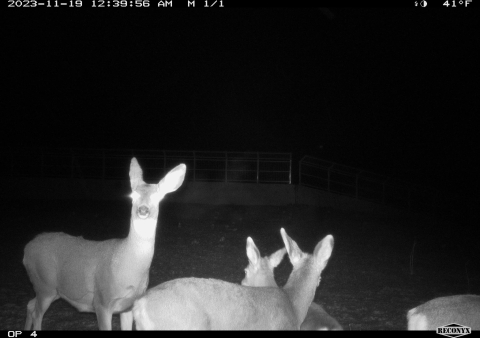Approximately 10 miles east of Boise, Idaho State Highway 21 cuts across the migration routes of thousands of mule deer and elk. In this area around Cervidae Peak, roughly 8,000-9,000 mule deer and 1,800-2,400 elk of the Boise River herds cross the increasingly busy highway twice each year during their seasonal migrations. This stretch of highway had become a concern for the Idaho Transportation Department due to dangerous and costly vehicle wildlife collisions, but a newly completed Cervidae Peak Wildlife Overpass aims to improve safety for both drivers and animals.
Overpass construction cost roughly $6.5 million and was funded by a Federal Lands Access Program grant administered by the Federal Highways Administration along with a consortium of partners providing matching funds. A significant portion of Idaho Fish and Game’s matching contribution was made with Wildlife Restoration funds administered through the U.S. Fish and Wildlife Service’s Office of Conservation Investment.
“The Idaho Transportation Department recognizes the vital role of Highway 21 as a conduit between high alpine summer havens and lower river valley winter retreats for big game species,” said Sophia Miraglio, Public Information Officer for the Idaho Transportation Department. “The Cervidae Overpass is expected to reduce wildlife collisions in the area by 80 percent, a feat made achievable through collaboration with our wildlife and land management partners." Only weeks after completion, trail cameras showed what project partners were hoping for, mule deer using the structure structure
Something temporarily or permanently constructed, built, or placed; and constructed of natural or manufactured parts including, but not limited to, a building, shed, cabin, porch, bridge, walkway, stair steps, sign, landing, platform, dock, rack, fence, telecommunication device, antennae, fish cleaning table, satellite dish/mount, or well head.
Learn more about structure to avoid the highway. On a roadway that hosts a daily average of 14,000 vehicles, these deer were some of the first to use the structure to cross above the highway and avoid collisions.
Traditionally, fences have been used to keep wildlife off roadways. However, exclusionary fencing can also impact big game migrations. Build a fence tall enough and it will keep wildlife out, but it can also keep wildlife from their centuries’ old migration paths. “Our partners at the Idaho Transportation Department recognized that their mission to make roadways safer could combine with our mission to conserve wildlife and this overpass allows for increased road safety while still allowing yearly deer and elk migrations,” said Frank Edelmann, Technical Services Bureau Chief at Idaho Fish and Game. Herds in the area winter in the lower elevation Boise River corridor and migrate to summer ranges as far away as the Sawtooth Mountains, meaning that at least twice a year these animals are crossing the busy highway.
“Without access to this important migration path, deer might be forced to stay at higher elevations during the winter months,” added Edelmann. “During harsh winters, deer prevented from accessing low elevation winter range could experience large die offs due to limited food resources and harsh conditions.”
The wildlife overpass at Cervidae Peak is approximately 150 ft wide and is located at mile post 19.3. The site was selected within the mapped wildlife migration routes to capitalize on an existing roadcut and nearby terrain reducing the overpass construction costs. The Idaho Transportation Department developed and led the overpass project bringing together numerous supporting stakeholders including Idaho Fish and Game, U.S. Forest Service, Army Corps of Engineers, the City of Boise, Ada and Boise Counties, numerous non-governmental organizations, and the Western Federal Lands Highway Division of the Federal Highways Administration.
The funds provided by Idaho Fish and Game were administered through the Office of Conservation Investment and represent a portion of the state’s Wildlife Restoration grant annual apportionments. Wildlife Restoration grants, funded through manufacturer paid excise taxes on firearms and ammunition, support efforts to restore, conserve, manage and enhance wild birds and mammals and their habitat. “Our state agency partners rely on Wildlife Restoration funds to support efforts from hunter education courses, habitat restoration, and in this case the creation of a wildlife overpass to aid deer and elk migration,” said Kyle James, Wildlife Biologist with the Office of Conservation Investment. “In recent years, Idaho Fish and Game has received around $19 million annually in Wildlife Restoration grant funding. By collaborating with others on projects, they are able to share costs and increase wildlife benefits.”
As herds begin their spring migration, state officials remind the public that deer and elk will continue to familiarize themselves with the new overpass and motorists should continue to exercise caution. Motorists could still see some animals directly crossing Highway 21 via the roadway. Overpass use is often a learned behavior for wildlife and some animals will likely still be on the highway.
“We know that the overpass was working soon after completion, even before trail cameras were installed, when we saw deer tracks across the structure,” added Edelmann. “But wildlife will need time to get accustomed to the overpass before it becomes habit to utilize it.” Idaho Fish and Game will continue to monitor wildlife use of the overpass with cameras to learn if improvements can be made to this project and inform possible future projects.
For more information on the Cervidae Peak Wildlife Overpass visit https://itd.idaho.gov/env/?target=wildlife.






